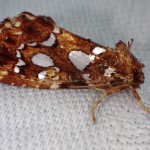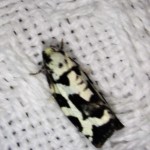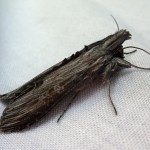Moth watching beginners are invited to a Moth and Muffin event at our house on a Maine island next to a nature preserve during Moth Week, July 25. From 5 AM to 8 AM we will be serving blueberry muffins and pointing out the moths clinging to our sheets before we cover them with a shower curtain liner. We choose to protect the moths from the birds and red squirrels, who have learned to come to the “breakfast bar” for moths that have not yet aroused from their night of black light stupor. We know the few moth fatalities that our investigations cause will not harm moth populations. We know the predators need to eat too, but they can catch their moth meals without our help. No arguments; just enjoyment.
The Moth Diaries is the title of my forthcoming book about our experience as moth watching beginners. As a natural history writer I write about birds and environments. Along with my husband, retired ecologist who spent his career studying island biogeography, we thought we were pretty familiar with the day time world around us. However, when we began to hang out a light to meet the moths, we were humbled and amazed by the night time world that surrounded us. Academically we appreciated moths, but in practice we had been almost totally unaware of what we were missing. Yes, even in our cities and suburbs there is an astonishing wealth of moths awaiting everyone who watches. Moth watching is a process that is so enticing we had to share it.
Every day for a year we recorded the data, kept a diary you might say. Before our Maine winter snow had melted we learned of Facebook groups and other online resources we could look forward to using as spring brought us moths. Tantalizing reports from the south made us wonder could reports from other regions show us what moths to expect? Yes. Their posts helped us riffle through the field guide for a picture match, which is how most beginners learn to identify moths. I, however, still do not feel I need to put a name on every moth I see anymore than I feel the need to identify every plant I see. (Okay, I’m actually pretty much a botanist— but not a horticulturist—so I do draw the line at naming every garden specimen I see. I just appreciate the flowers—and so it is with moths. )
At first we enjoyed holding a Sherlock Holmes-style magnifying glass over the moths. The moths often did not sit around for that. Better to view their portraits on computer screen where one can really appreciate their fantastic detail. The development of digital cameras and the publication of newer field guides have ushered in a revolution much like that which swept the birding world some years ago. Moth watching is the new birding, or what to do when your bird list is pretty full.
Moth enthusiasts can work their way as far as they wish through the spectrum of photographing with their smartphone, using a simple point and shoot camera with good macro capabilities, to buying and learning to use whatever Single Lens Reflex camera and fancy lenses they can afford. We also found there is a wide gamut of options from free sharpening software to using programs like Photoshop to improve moth photos beyond simple cropping etc. The same can be said for lights: use your porch light, a party ultraviolet bulb, an ordinary bug zapper having cut the wire that electrocutes the insects, to a special UV bulb or even a mercury vapor lamp from commercial suppliers.
Almost every night all summer long—from frost to frost—we saw a moth that was new to us. They ranged from the celebrity-in-sunglasses markings of the Boldly-marked Archips, Archips dissitana, or the dazzling little Silver-spotted Fern Moth, Callopistria cordata, to the almost wolfish Dusky Hooded Owlet, Cucullia intermedia, and of course, everyone’s favorite, the lovely Luna, Actias luna. (Unlke in Britain where moth common names are well established, in this country that is not so. Serious moth-ers prefer to use the scientific name and perhaps even add the Hodges number.) Note the raindrops on the Luna’s wing—unless there was a full moon or hard rain or it was too windy, the moths flew. We lured them with sugar bait or beat the bushes for their caterpillars when we felt up to that even more challenging fun.
The beginning moth watcher will find that online Facebook pages for your region are cruised by experts who race each other to identify your photographs of mystery moths. Or blow your mind with images from around the world with the Mothing and Moth-watching Group page on Facebook. You may start dreaming of mothing vacations in Malaysia or Costa Rica! MPG (Moth Photographers Group) and bugguide.net offer more challenge, more experts, and there are many citizen science pages such as BAMONA, Butterfly and Moths of North America where you can post your data on line. The Xerces Society focuses exclusively on invertebrates, and various state experiment stations have ongoing moth research. Many Universities can connect you with experts to contact. Once you become serious about the science, you will find workshops where you can learn about scholarly references, museums of the world, field pinning, serious specimen preparing and dissection, and collection care. (What a thrill when we found a moth that Cornell University was interested in!) Wherever you are along your journey, there is always something more to be learned, another moth to see.
Moth watching offers a life-long passion. You will never run out of moths (if we humans don’t spoil all the habitat first).Even if you do not love data, you may find yourself filing moth photos and writing your very own mothing diary. You will marvel that such wonders were at your doorstep all the while. You just needed to learn to look. What a grand beginning!




Yes! Yes! And Yes! Thanks, Marnie!